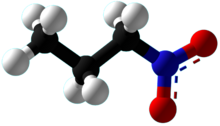Chemistry:1-Nitropropane

| |

| |
| Names | |
|---|---|
| Preferred IUPAC name
1-Nitropropane | |
| Identifiers | |
3D model (JSmol)
|
|
| Abbreviations | 1-NP |
| ChEBI | |
| ChemSpider | |
| EC Number |
|
| MeSH | C035314 |
PubChem CID
|
|
| UNII | |
| |
| |
| Properties | |
| C3H7NO2 | |
| Molar mass | 89.094 g·mol−1 |
| Appearance | Colorless liquid[1] |
| Odor | Disagreeable[2] |
| Density | 0.998 g/cm3 |
| Melting point | −108 °C (−162 °F; 165 K) |
| Boiling point | 132 °C (270 °F; 405 K) |
| 1.4 mg/L | |
| Solubility | soluble in chloroform |
| Vapor pressure | 8 mmHg (20°C)[2] |
| Acidity (pKa) | 17.0 [3] |
| Viscosity | 0.844 cP |
| Hazards | |
| NFPA 704 (fire diamond) | |
| Flash point | 35 °C (95 °F; 308 K) |
| 420 °C (788 °F; 693 K) | |
| Explosive limits | 2.6-11.0% |
| Lethal dose or concentration (LD, LC): | |
LD50 (median dose)
|
800 mg/kg (mouse, oral) 455 mg/kg (rat, oral)[4] |
LDLo (lowest published)
|
250 mg/kg (rabbit, oral)[4] |
LC50 (median concentration)
|
3100 ppm (rat, 8 hr)[4] |
| NIOSH (US health exposure limits): | |
PEL (Permissible)
|
TWA 25 ppm (90 mg/m3)[2] |
REL (Recommended)
|
TWA 25 ppm (90 mg/m3)[2] |
IDLH (Immediate danger)
|
1000 ppm[2] |
Except where otherwise noted, data are given for materials in their standard state (at 25 °C [77 °F], 100 kPa). | |
| Infobox references | |
1-Nitropropane (1-NP) is a solvent. It is a colorless liquid, an isomer of 2-nitropropane (2-NP), and classified as a nitro compound.
Preparation
1-nitropropane is produced industrially by the reaction of propane and nitric acid. This reaction forms four nitroalkanes: nitromethane, nitroethane, 1-nitropropane, and 2-nitropropane. 1-nitropropane is also a byproduct of the process for making 2-nitropropane, which is done by vapour phase nitration of propane.
Uses
Most 1-nitropropane is used as a starting material for other compounds. The other uses are solvent-based paints, solvent-based inks and adhesives, and as a solvent for chemical reactions.[5]
Safety
1-nitropropane is toxic to humans and can cause damage to the kidneys and liver. The vapours are irritating for the lungs and eyes and the maximum exposure rate is 25 ppm.[6] It is not known to be a carcinogen.
Reactions
1-nitropropane decomposes under the influence of heat into toxic gases. It also reacts violently with oxidizing agents and strong bases.
References
- ↑ - MDMS sheets
- ↑ 2.0 2.1 2.2 2.3 2.4 NIOSH Pocket Guide to Chemical Hazards. "#0459". National Institute for Occupational Safety and Health (NIOSH). https://www.cdc.gov/niosh/npg/npgd0459.html.
- ↑ Reich, Hans. "Bordwell pKa table: "Nitroalkanes"". http://www.chem.wisc.edu/areas/reich/pkatable/. Retrieved 17 January 2016.
- ↑ 4.0 4.1 4.2 "1-Nitropropane". Immediately Dangerous to Life and Health Concentrations (IDLH). National Institute for Occupational Safety and Health (NIOSH). https://www.cdc.gov/niosh/idlh/108032.html.
- ↑ "- information sheet". http://msdssearch.dow.com/PublishedLiteratureDOWCOM/dh_0485/0901b803804857f0.pdf?filepath=productsafety%2Fpdfs%2Fnoreg%2F233-00667.pdf&fromPage=GetDoc.
- ↑ - MDMS sheets
 |


